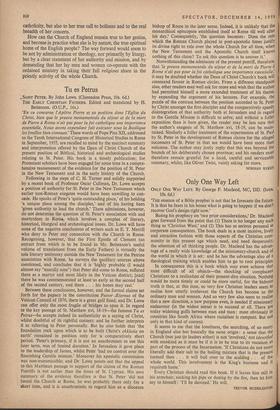Tu es Petrus
'En ce concerne l'Apotre Pierre et sa position dans l'Eglise du Christ, bien que le preuve monumentale du sejour et de la Mort de Pierre a Rome n'ait pas pour la foi catholique une importance essentielle, Nous avons cependant fait executer sous la Basilique les fouilles bien connues.' These words of Pope Pius XII, addressed to the Tenth International Congress of Historical Studies in Rome in September, 1955, are recalled to mind by the succinct summary and interpretation offered by the Dean of Christ Church of the present position of Biblical, historical and archaeological studies relating to St. Peter. His book is a timely publication; for Protestant scholars have been engaged for some time in a compre- hensive reassessment of the evidence for the position of St. Peter in the New Testament and in the early history of the Church.
Following in the steps of C. H. Turner and solidly supported by a recent book of Professor Oscar Cullman, Dr. Lowe accepts a position of authority for St. Peter in the New Testament which earlier non-Roman exegetes would have been unwilling to con- cede. He speaks of Peter's 'quite outstanding place,' of his holding 'a unique place among the disciples,' and of his having been 'given authority to lead the church.' These admissions, however, do not determine the question of St. Peter's association with and martyrdom in Rome, which involves a complex of literary, historical, liturgical and archaeological issues. Dr. Lowe will have none of the negative conclusions of writers such as E. T. Merrill who deny to Peter any connection with the Church in Rome. Recognising, however, that the First Epistle of Clement (an extract from which is to be found in Mr. Bettenson's useful volume of translations from the Early Fathers) is virtually the sole literary testimony outside the New Testament for the Petrine association with Rome, he surveys the ancillary sources above mentioned, and concludes that it is 'higibly probable (I would almost say "morally sure") that Peter did come to Rome, suffered there as a martyr and most likely in the Vatican district; [and] there he was commemorated at least as early as the second half of the second century, and there . . . his bones may rest.'
Between these conclusions, however, and the formal claims set forth for the papacy in the constitution Pastor iEternus of the Vatican Council of 1870, there is a great gulf fixed; and Dr. Lowe can offer only the most fragile of bridges to span it. In regard to the key passage of St. Matthew xvi, 18-19—the famous Tu es Petrus—he accepts indeed its authenticity as a saying of Christ, whilst doubtful of its rightful context; and he further interprets it as referring to Peter personally. But he also holds that 'the foundation rock upon which is to be built Ohrist's ekklesia on earth' remained in position only for a comparatively short period. 'Peter's primacy, if it is not an anachronism to use this later term, was of limited duration.' In Jerusalem it gave place to the leadership of James, whilst Peter 'had no control over the flourishing Gentile mission.' Moreover his apostolic commission was non-transmissible; and Dr. Lowe points out that the appeal to this Matthean passage in support of the claims of the Roman Pontiffs is not earlier than the times of St. Cyprian. His own summary of the evidence therefore is that St. Peter 'did not found the Church at Rome, he was probably there only for a short time, and it is anachronistic to regard him as a diocesan
bishop of Rome in the later sense. Indeed, it is unlikely that the monarchical episcopate established itself at Rome till well after his day.' Consequently, 'the question becomes : Does the role which the Roman Church played in post-apostolic times justify its divine right to rule over the whole Church for all time, when the New Testament and the Apostolic Church itself knows nothing of this claim? To ask this question is to answer it.'
Notwithstanding the admission of the present pontiff, therefore, that 'le preuve monumentale du sejour et de la mort de Pierre t! Rome n'ait pas pour la foi catholique une importance essentielle, it may be doubted whether the Dean of Christ Church's book will command favour in Roman circles. From a different standpoint also, other readers may well ask for more and wish that the author had permitted himself a more extended treatment of his theme, by expanding the argument of his lectures. For example, the puzzle of the contrast between the position accorded to St. Peter by Christ amongst the first disciples and the comparatively speedY disintegration of that authority both at Jerusalem and in regard to the Gentile Mission is difficult to solve; and without a fuller exposition than is here given, the reader may be less sure that the author's exegesis of St. Matthew xvi, 18-19, can be main- tained. Similarly a fuller treatment of the supersession of St. Paul by St. Peter in the development of Roman claims for the alleged successors of St. Peter in that see would have been more than welcome. The author may justly reply that this was beyond the bounds of his deliberately chosen province; and his readers must therefore remain grateful for a lucid, careful and serviceable summary, whilst, like Oliver Twist, vainly asking for more.
NORMAN SYKES










































 Previous page
Previous page